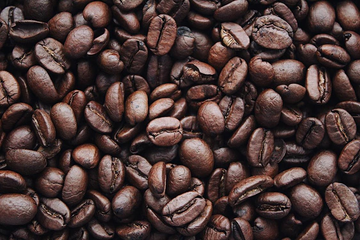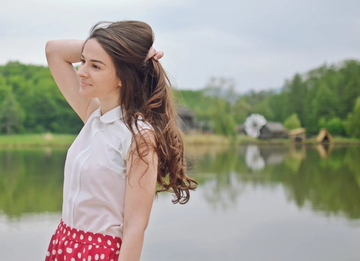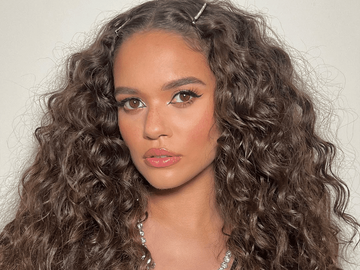Summer: the season of sun-kissed skin, beachy vibes, and endless outdoor fun. But between the sun's scorching rays, salty sea breezes, and chlorinated pool dips, your hair can quickly turn into a dry, frizzy mess. So, we're diving deep into the world of summer hair care to keep those tresses looking fabulous all season long. From must-have products to simple tips and tricks, consider this your ultimate guide to maintaining a mane that shines as bright as the summer sun.
Why does your hair need extra love in the summer?
In the glorious heat of summer, our hair faces a veritable assault from the elements. The sun's UV rays don't just burn our skin—they also strip moisture from our hair, leaving it dry and prone to breakage. Imagine each strand as a tiny piece of fabric: too much sun exposure, and it starts to fray and lose its vibrant color.
But the sun isn’t the only culprit. Add in salty sea water from your beach trips and chlorine from your pool days, and you've got a recipe for seriously stressed-out locks. Saltwater draws moisture from your hair, making it brittle, while chlorine bonds with hair, leading to discoloration and further dryness. Even the increased humidity that makes your skin glow can wreak havoc, leading to frizz and flyaways that are tough to tame.
Summer activities often mean more frequent washing to rinse out sweat and grime, which can strip away natural oils that protect and nourish hair. All these factors combined mean our hair needs extra TLC during these sun-soaked months. When you adjust your hair care routine to address these unique challenges, your locks will stay healthy, shiny, and summer-ready.
Tip one: Maximize that moisture
Hydrating your hair is crucial, especially during the summer when it's more prone to dryness and damage.
Why hydration is important
– Prevents dryness and brittle hair: The summer sun, saltwater, and chlorine can strip your hair of its natural moisture, making it dry and brittle. Hydrated hair is more resilient and less likely to break or develop split ends.
– Maintains elasticity and strength: Well-hydrated hair retains its elasticity, reducing the risk of breakage when styling or brushing. Moisture also strengthens the hair shaft, making it more resistant to damage.
– Enhances shine and smoothness: Moisturized hair reflects light better, giving it a shiny, healthy appearance. It also feels smoother and is less prone to frizz and flyaways, which are common issues in humid summer weather.
– Protects color: If your hair is colored, hydration helps maintain the vibrancy of that color by preventing it from fading due to dryness and exposure to the elements.
How to keep your hair hydrated
Drink plenty of water. Drinking enough water ensures that your body, including your hair follicles, stays hydrated. Aim for at least 8 glasses of water a day.
Use hydrating hair products. Choose shampoos, conditioners, and styling products that are specifically formulated to hydrate hair. Look for ingredients like glycerin, hyaluronic acid, aloe vera, and natural oils (coconut, argan, or jojoba oil).
Tip two: Beat the heat
Using hot tools less frequently during the summer is a wise move for several reasons, and it should help improve its health.
Why less heat is beneficial
– Reduces damage: Heat styling tools like flat irons, curling irons, and blow dryers can cause damage to your hair, particularly when used frequently. Excessive heat exposure weakens the hair shaft, leading to dryness, breakage, and split ends.
– Minimizes dryness: Summer heat already dehydrates your hair, and adding additional heat from styling tools exacerbates this dryness. By minimizing heat styling, you help retain the natural moisture in your hair, keeping it hydrated and supple.
– Prevents color fading: If your hair is colored, heat styling can accelerate color fading, causing your vibrant summer hues to dull prematurely. By avoiding excessive heat, you prolong the vibrancy of your color and extend the time between touch-ups.
– Reduces frizz: Heat styling can contribute to frizz by drying out the hair and disrupting its natural texture. Limiting heat exposure helps maintain the hair's natural oils and cuticle smoothness, reducing frizz and flyaways, especially in humid summer conditions.
How to minimize heat damage
Air dry often. Allow your hair to dry naturally to minimize heat exposure and preserve its moisture levels.
Use heat-protectant products. Always apply a heat protectant spray or serum to your hair before heat styling to create a barrier between your hair and the heat, reducing damage and preventing moisture loss.
Lower heat settings. If you can’t put down those heat tools, opt for lower temperature settings to reduce the risk of damage. As well, choose a hot tool made with materials like titanium that are kinder to your hair.
Limit frequency. Reserve heat styling for special occasions rather than making it a daily routine. This gives your hair a break from heat exposure, allowing it to recover and maintain its health.
Choose heat-free hairstyles. Explore styles like braids, buns, or twists that don't require heat styling. These styles not only protect your hair from damage but also help retain moisture and reduce frizz.
Tip three: Step away from the shampoo
Washing your hair less frequently during the summer helps maintain the natural balance of oils in your scalp and hair, resulting in healthier and more manageable locks.
Why less washing is beneficial
– Preserves natural oils: Shampooing too often can strip your scalp and hair of their natural oils, leading to dryness and potential issues like dandruff. Allow these oils to accumulate so you can develop your own natural hair hydration and protection.
– Reduces dryness: Summer heat and sun exposure can already dehydrate your hair, making it more susceptible to dryness and damage. Washing less frequently helps retain moisture in your hair, so it’s less prone to frizz.
– Extends color vibrancy: If your hair is color-treated, washing it less will prolong the vibrancy of your color and extend the time between salon visits, saving both time and money.
How to wash less frequently
Use dry shampoo. Dry shampoo is a lifesaver for extending time between washes. It absorbs excess oil from your scalp, refreshes your hair, and adds volume, so you can go longer without shampooing.
Focus on scalp cleansing. When you do shampoo, focus on cleansing your scalp rather than your entire length of hair. Massage the shampoo into your scalp to remove dirt, oil, and product buildup, then let the suds rinse down the length of your hair as you wash it out.
Rinse with water only. On days when you don't shampoo, simply rinse your hair with water in the shower to remove sweat, salt, and chlorine. This helps refresh your hair without stripping away its natural oils.
Use sulfate-free shampoo. Sulfates can be harsh and drying, especially when used frequently, so choosing a milder option is key to maintaining your hair's health.
Tip four: Keep it cool
Rinsing your hair with cool water, particularly during the summer months, offers several benefits for your hair's health and appearance.
Why cool water is better
– Seals the cuticle: Cool water helps to close the hair cuticle, which is the outermost layer of the hair shaft. When the cuticle is sealed, it lays flat, resulting in smoother, shinier hair.
– Locks in moisture: Warm or hot water can open the hair cuticle, allowing moisture to escape more easily. Cool water, on the other hand, helps to seal in moisture, keeping your hair hydrated and reducing the risk of dryness and frizz.
– Soothes the scalp: Cool water can have a soothing effect on the scalp, particularly during hot summer days when your scalp may feel irritated or overheated.
How to rinse with cool water
Finish with a cool rinse. After shampooing and conditioning your hair, finish your shower by rinsing with cool water, ensuring all traces of shampoo and conditioner are thoroughly rinsed out.
Adjust water temperature gradually. If you're used to rinsing with warm water, gradually lower the temperature during your rinse until it reaches cool or cold. This allows your hair and scalp to adjust to the change in temperature without shock.
Consider a final rinse: Doing a final rinse with cold water specifically targeting the scalp can help to invigorate the hair follicles and encourage healthy hair growth. And, it’s super refreshing when it’s hot outside.
Tip five: Go natural with color
Coloring your hair less frequently during the summer is ideal because it helps maintain the health and integrity of your hair during that harsher, hotter weather.
Why coloring less frequently is better
– Reduces damage: Hair coloring involves chemical processes that can weaken the hair shaft, making it more susceptible to breakage and dryness. By coloring your hair less frequently, you minimize the damage caused by these chemical treatments.
– Preserves moisture: Coloring treatments, especially those involving bleach or lightening agents, can strip the hair of its natural moisture. Coloring less frequently allows your hair to retain those natural oils, keeping it hydrated and reducing the risk of dryness and damage.
– Minimizes stress on hair: Chemical processes associated with hair coloring can cause stress and strain on the hair follicles and cuticle. By spacing out coloring appointments, you give your hair time to recover.
How to color less frequently
Opt for low-maintenance color. Choose color options that require less frequent touch-ups, like balayage, ombre, or subtle highlights. These techniques blend seamlessly with your natural hair color, so you don’t have to go to the salon as often.
Consider semi-permanent options. Semi-permanent or demi-permanent hair colors are gentler on the hair and fade more gradually over time compared to permanent dyes. Opting for these types of color treatments can help reduce the need for touch-ups and minimize damage.
Focus on hair health. Prioritize the health and condition of your hair by incorporating regular deep conditioning treatments and using nourishing hair care products specifically formulated for color-treated hair. Healthy hair holds color better and is more resilient.
Protect your color: Shield your hair from sunlight, chlorine, and saltwater by wearing a hat or using UV-protectant hair products when you’re outdoors. Additionally, rinse your hair with fresh water after swimming to remove chlorine and salt residue that can cause color fading.
Tip six: Cover it up
Covering your hair and using hair sunscreen are key for maintaining the health and integrity of your hair during the summer.
Why covering your hair and using sunscreen is best
– Protects from UV damage: Just like your skin, your hair is susceptible to damage from the sun's ultraviolet (UV) rays. Covering your hair with a hat or scarf provides physical protection from UV rays, while hair sunscreen adds an extra layer of defense against that UV damage.
– Prevents color fading: UV rays can cause color-treated hair to fade more quickly, so using hair sunscreen helps preserve the vibrancy of your color.
– Reduces dryness and breakage: Sun exposure can remove your hair’s natural moisture, leading to dryness, brittleness, and increased susceptibility to breakage. Hair sunscreen helps it retain moisture and prevents damage caused by UV-induced dryness.
– Minimizes frizz and damage: UV radiation can also damage the cuticle of your hair, leading to increased frizz and roughness. Hair sunscreen forms a protective barrier around your hair, helping to seal the cuticle and minimize frizz.
How to protect your hair from the sun
Wear a hat or scarf. When spending time outdoors, especially during peak sun hours, protect your hair by wearing a wide-brimmed hat or lightweight scarf.
Apply hair sunscreen before you go outside. Before heading outdoors, apply hair sunscreen evenly throughout your hair, focusing on areas that are most exposed to sunlight, like the top of your head and the lengths of your hair. Reapply as needed, especially after swimming or sweating.
Opt for protective hairstyles. Consider styling your hair in protective styles, like braids, buns, or twists, which help minimize sun exposure and reduce the risk of damage. These styles also keep your hair off your face and neck, helping you stay cool in the summer heat.
Tip seven: Chop it off
Cutting your hair during the summer is a great idea to maintain its health, and who doesn’t love a chic bob for the warmer months?
Why removing some length works
– Removes split ends: Exposure to sunlight, heat, and humidity during the summer can cause split ends, leading to dry, frizzy, and damaged hair. Regular haircuts help get rid of those split ends and prevent them from traveling up the hair shaft so your hair looks healthier.
– Promotes hair growth: Trimming your hair regularly stimulates hair growth by removing damaged and weakened hair, allowing new, healthier strands to grow in their place. This can result in thicker, more voluminous hair.
– Improves manageability: Shorter haircuts can be more manageable and easier to style during the summer, especially when it’s hot and humid.
– Air flow: Long hair can trap heat and moisture close to the scalp, leading to discomfort and potentially contributing to scalp issues like dandruff and itchiness. Cutting your hair shorter allows for better air circulation around the scalp, keeping it cooler and more comfortable in the summer heat.
How to get the perfect summer chop
Head to the salon. Schedule an appointment with your stylist, who can assess the condition of your hair and recommend the perfect haircut for you, and the summer heat.
Regular maintenance. Maintain your haircut by scheduling regular trims every six to eight weeks to keep your hair looking fresh and healthy, especially if you’ve chosen a super short style. Regular trims prevent split ends from worsening and help maintain the shape and integrity of your haircut over time.
Experiment with styles. Embrace the versatility of shorter haircuts by experimenting with different styling techniques and products to achieve different looks. From sleek and polished to tousled and textured, short hair offers endless styling possibilities.
Now you (and your hair) are set for summer
With the scorching sun and fun-filled activities of summer, our hair needs a little extra love and attention. From shielding it from UV rays to hydrating it regularly, you should have what you need to keep your locks looking luscious all season long.
Remember, hydration is key, whether it's sipping on water to keep your strands moisturized from within or using hydrating hair products to combat the drying effects of the sun. Be sure to rinse your hair after swimming to remove chlorine and saltwater residue, and embrace protective hairstyles and hats to shield your tresses from the elements.
Additionally, consider cutting your hair shorter for a fresh and manageable summer look, and minimize heat styling to prevent further damage. And don't forget that hair sunscreen to protect your strands from UV damage and color fading.
Incorporating these summer hair care tips into your routine gives your hair the opportunity to look healthy and vibrant all season long. So embrace the sunshine, and let your hair shine bright like the summer sun.





